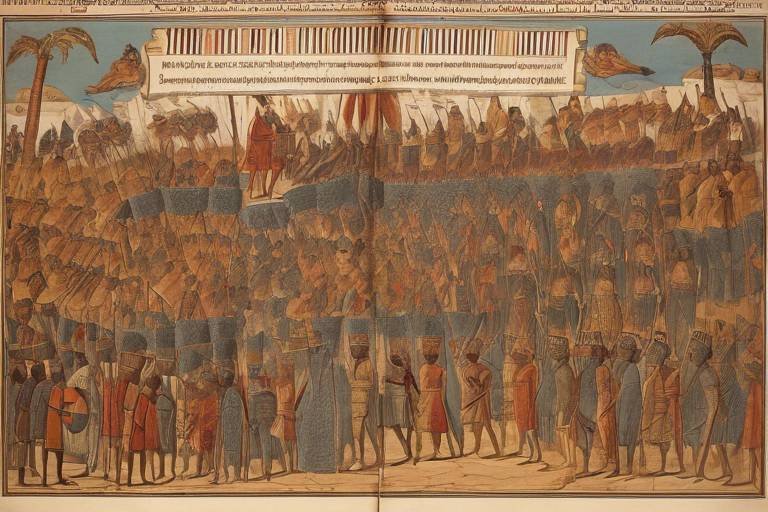The Rise and Fall of the Mongol Empire - An Analysis
The Mongol Empire, a colossal force that once dominated vast swathes of the known world, stands as a testament to the power and ambition of one of history's most formidable empires. From its humble beginnings under the visionary leadership of Genghis Khan to its eventual fragmentation and decline, the rise and fall of the Mongol Empire remains a captivating saga of conquest, innovation, and legacy.
At the zenith of its power, the Mongol Empire spanned from Asia to Europe, encompassing diverse cultures and peoples under its rule. The military prowess of the Mongols, coupled with their strategic acumen, enabled them to conquer territories with unprecedented speed and efficiency. The empire's expansion was marked by a series of conquests that reshaped the geopolitical landscape, from the heart of China to the fringes of Russia.
Central to the success of the Mongol Empire was its innovative administrative systems, such as the Yam system, which facilitated communication and governance across vast distances. Moreover, the Mongols' policy of religious tolerance allowed them to govern diverse populations with relative ease, fostering stability and cooperation within their realms.
On the economic front, the Mongols implemented policies that promoted trade and commerce, notably along the fabled Silk Road. Their adoption of paper currency revolutionized financial transactions and facilitated the exchange of goods and ideas across continents, leaving a lasting impact on global commerce.
However, internal strife and succession disputes plagued the empire following the death of Genghis Khan, leading to a gradual decline in its power and influence. Overextension, internal divisions, and external pressures from rival powers all contributed to the eventual fragmentation of the once-mighty Mongol Empire.
Despite its eventual demise, the legacy of the Mongol Empire endures in the cultural exchanges, technological advancements, and intellectual contributions it facilitated. The empire's impact on the regions it once controlled reverberates through history, shaping the course of world events and influencing global interactions for centuries to come.
In conclusion, the rise and fall of the Mongol Empire stands as a pivotal chapter in the annals of human history, a saga of conquest and conquest, innovation and legacy that continues to captivate the imagination of scholars and enthusiasts alike. The enduring legacy of the empire serves as a reminder of the complexities of power, ambition, and the inexorable march of time.

Origins of the Mongol Empire
The can be traced back to the early 13th century when a visionary leader named Genghis Khan emerged from the steppes of Central Asia. Genghis Khan, known for his military prowess and strategic brilliance, united the disparate Mongol tribes under his rule through a combination of diplomacy, alliances, and military conquests. With a keen understanding of warfare and a relentless drive for expansion, Genghis Khan laid the foundation for what would become one of the most formidable empires in history.
At the heart of the Mongol Empire's origins was Genghis Khan's innovative approach to leadership and governance. Unlike many other rulers of his time, Genghis Khan promoted meritocracy within his ranks, rewarding skill and loyalty rather than noble birth. This egalitarian ethos allowed the Mongols to harness the talents of individuals from diverse backgrounds, creating a highly effective and adaptable military force.
One of the key strategies that propelled the early success of the Mongol Empire was their mastery of mounted warfare. The Mongols were renowned for their expertise in horseback riding, archery, and swift maneuvering on the battlefield. This mobility and flexibility gave them a significant advantage over sedentary societies, allowing them to strike quickly and decisively against their enemies.
As Genghis Khan consolidated his power and expanded his territory, he also implemented a system of laws and codes known as the Yassa. The Yassa served as a comprehensive legal framework that governed various aspects of Mongol society, from military discipline to trade regulations. This codification of laws helped maintain order within the empire and ensured uniformity in governance across vast regions.
Furthermore, the early Mongol Empire was characterized by a strong sense of unity and shared purpose among its people. The Mongols were bound together by a common identity, language, and nomadic lifestyle, fostering a sense of camaraderie and solidarity that bolstered their military campaigns and administrative efforts.
In essence, the origins of the Mongol Empire can be attributed to the visionary leadership of Genghis Khan, the innovative strategies employed by the Mongols, and the cohesive unity that bound them together as a formidable force on the world stage.

Conquests and Expansion
During the height of its power, the Mongol Empire embarked on a series of conquests and expansions that reshaped the political landscape of Asia and Europe. Led by formidable leaders such as Genghis Khan and his successors, the Mongols employed innovative military strategies and tactics to conquer vast territories and establish the largest land empire in history.
One of the key factors that enabled the Mongols to achieve such remarkable success in their conquests was their superior military prowess. The Mongol armies were highly skilled in horseback warfare and archery, allowing them to swiftly maneuver across various terrains and outmaneuver their opponents on the battlefield. Additionally, the Mongols were adept at incorporating diverse ethnic groups and cultures into their military forces, creating a formidable and diverse army that could adapt to different combat situations.
One of the most renowned conquests of the Mongol Empire was the invasion of China under the leadership of Kublai Khan, the grandson of Genghis Khan. The Mongols successfully overthrew the Song Dynasty and established the Yuan Dynasty, marking the first time that China was ruled by a non-native dynasty. This conquest not only expanded the Mongol Empire's influence but also facilitated cultural exchanges and trade between East and West.
Furthermore, the Mongols conquered Persia and Russia, incorporating these regions into their vast empire and further extending their dominance over key trade routes and strategic territories. The Mongol conquests in these regions had lasting effects on the political, economic, and cultural landscapes of the conquered territories, shaping their development for centuries to come.
Despite their military successes, the Mongols also faced significant challenges in maintaining control over their vast empire. The sheer size of the empire and the diverse populations under Mongol rule posed administrative and logistical challenges that strained the empire's resources and governance systems. Internal conflicts and succession disputes among the Mongol leaders also weakened the empire's unity and stability, ultimately contributing to its eventual fragmentation and decline.
In conclusion, the conquests and expansions of the Mongol Empire were characterized by military prowess, cultural exchanges, and political dominance. The legacy of the Mongol Empire's conquests continues to resonate in the regions it once controlled, shaping the course of history and influencing global interactions for centuries to come.

Administrative Innovations
Exploring the key events and factors that led to the establishment and eventual decline of one of the largest empires in history, the Mongol Empire, and analyzing its impact on global history.
During their reign, the Mongols introduced several innovative administrative systems that played a crucial role in governing their vast empire. One of the most notable systems was the Yam, a sophisticated communication network that enabled efficient relay of messages and goods across the empire. This network of relay stations allowed the Mongols to stay connected and informed, facilitating swift decision-making and coordination of military campaigns.
Moreover, the Mongols exhibited a remarkable degree of religious tolerance, allowing the diverse populations within their empire to practice their own faiths without persecution. This policy of religious freedom not only promoted social harmony but also contributed to the stability of the empire by reducing internal unrest based on religious differences.
Additionally, the Mongols implemented a merit-based system of governance, where individuals were appointed to administrative positions based on their skills and capabilities rather than hereditary status. This approach ensured that competent individuals were placed in key positions of authority, enhancing the efficiency and effectiveness of the Mongol administration.
Furthermore, the Mongols' adoption of a standardized legal code, known as the Great Yasa, helped in maintaining order and justice throughout the empire. This uniform set of laws governed various aspects of society, including property rights, criminal offenses, and social conduct, providing a sense of consistency and predictability for the diverse populations under Mongol rule.
In essence, the administrative innovations introduced by the Mongols not only facilitated their control over a vast and diverse empire but also contributed to the stability and functionality of their governance system, setting them apart from many contemporary empires of the time.
Q: What were the key administrative innovations of the Mongol Empire?
A: The key administrative innovations of the Mongol Empire included the Yam communication network, religious tolerance, merit-based governance, and the Great Yasa legal code.
Q: How did the Yam system contribute to the efficiency of the Mongol administration?
A: The Yam system facilitated rapid communication and transportation of goods, enabling quick decision-making and coordination of military campaigns across the vast Mongol Empire.
Q: Why was religious tolerance important in the Mongol Empire?
A: Religious tolerance promoted social harmony and stability by allowing diverse populations to practice their own faiths without fear of persecution, reducing internal conflicts based on religious differences.
Q: What role did the Great Yasa play in the governance of the Mongol Empire?
A: The Great Yasa provided a standardized legal code that governed various aspects of society, ensuring order, justice, and consistency in the administration of the empire.

Economic Impact
When delving into the economic impact of the Mongol Empire, one cannot overlook the significant changes and advancements that the empire brought to global commerce. The Mongols, under the leadership of Genghis Khan and his successors, implemented various economic policies that not only facilitated their rule but also had lasting effects on trade and finance.
One of the key economic strategies employed by the Mongols was the promotion of trade along the Silk Road. This ancient network of trade routes connecting East and West saw a resurgence during the Mongol rule, as the empire provided stability and security for merchants to travel and conduct business across vast distances.
Moreover, the adoption of paper currency by the Mongols revolutionized financial transactions in the regions under their control. The use of paper money facilitated trade and commerce, allowing for easier exchange of goods and services within the empire and beyond.
Additionally, the Mongol Empire's economic impact extended to the standardization of weights and measures, which further streamlined trade practices and fostered economic growth. By establishing uniform standards for trade, the Mongols created a more efficient and reliable commercial environment.
Furthermore, the Mongol Empire's economic policies not only influenced the economies of the lands they conquered but also had ripple effects on global commerce. The integration of diverse regions into the Mongol economic system promoted cross-cultural exchanges and the flow of goods and ideas across continents.
In conclusion, the economic impact of the Mongol Empire was profound and far-reaching, leaving a lasting legacy on trade, finance, and commercial interactions that reverberated throughout history.

Internal Struggles and Succession
Exploring the key events and factors that led to the establishment and eventual decline of one of the largest empires in history, the Mongol Empire, and analyzing its impact on global history.
Amidst the vast expanse of the Mongol Empire, internal struggles and succession battles brewed like a storm on the horizon. The death of Genghis Khan, the visionary leader who forged the empire, left a power vacuum that sparked fierce competition among his descendants. The concept of universal rulership clashed with the reality of familial ambitions, leading to a series of conflicts that threatened the unity of the empire.
As the empire expanded, the question of succession became increasingly complex. The tradition of elective succession clashed with the desire for hereditary rule, leading to disputes and rivalries among the Mongol elite. Each new leader faced the daunting task of balancing the demands of tradition with the realities of governance, often leading to internal strife and power struggles.
The struggle for supremacy within the Mongol Empire was not only a battle for political control but also a clash of ideologies and visions for the future. Different factions vied for dominance, each advocating for their own vision of the empire's direction. This internal discord weakened the empire from within, making it vulnerable to external pressures and threats.
Moreover, the vast size of the empire and the diverse cultures it encompassed added complexity to the internal struggles. The challenge of governing such a vast territory with varying customs and languages strained the administrative capabilities of the Mongol rulers, further exacerbating internal tensions and divisions.
Ultimately, the internal struggles and succession conflicts within the Mongol Empire played a significant role in its eventual fragmentation and decline. The inability to resolve these internal disputes effectively weakened the empire, paving the way for external powers to exploit its vulnerabilities and hasten its downfall.
- What were the main causes of the decline of the Mongol Empire?
- How did the Mongol Empire impact global history?
- What were some of the lasting legacies of the Mongol Empire?
The decline of the Mongol Empire was primarily caused by overextension, internal divisions, succession conflicts, and external pressures from rival powers.
The Mongol Empire had a profound impact on global history through cultural exchanges, technological advancements, and the spread of ideas across different regions.
The lasting legacies of the Mongol Empire include the promotion of trade along the Silk Road, the adoption of paper currency, and the dissemination of knowledge and innovations.

Decline and Fragmentation
As the Mongol Empire expanded to its peak, internal struggles and external pressures began to take their toll, leading to the gradual decline and eventual fragmentation of this once-mighty empire. One of the key factors that contributed to the decline of the Mongol Empire was overextension. The vast size of the empire, spanning from China to Eastern Europe, made it increasingly difficult to govern effectively and maintain control over distant territories.
Furthermore, internal divisions within the ruling elite and conflicts over succession after the death of key leaders, such as Genghis Khan, further weakened the unity of the empire. Power struggles among rival factions and family members often resulted in civil unrest and instability, undermining the cohesion of the Mongol domains.
External pressures from neighboring powers also played a significant role in the decline of the Mongol Empire. Rival empires and kingdoms, such as the Mamluks in Egypt and the rising power of the Ottoman Empire, posed continuous threats to Mongol territories, leading to conflicts and territorial losses.
Additionally, the lack of a clear and stable system of succession and governance after the death of strong leaders like Kublai Khan further exacerbated the internal turmoil within the empire. The absence of a centralized authority and the emergence of competing factions weakened the overall strength and coherence of the Mongol domains.
As the Mongol Empire faced mounting challenges both from within and outside, its once-unstoppable momentum began to falter. The fragmentation of the empire into separate khanates and the loss of key territories marked the final stages of the decline of this formidable empire, ultimately leading to its dissolution and the end of Mongol dominance over vast regions of Asia and Europe.

Lingering Legacy
The legacy of the Mongol Empire continues to reverberate through history, leaving a lasting impact on the regions it once dominated. One of the most significant contributions of the Mongols was their promotion of cultural exchanges across Eurasia. Through their vast empire, the Mongols facilitated the exchange of ideas, technologies, and goods between East and West, leading to a period of increased globalization.
Furthermore, the Mongols' conquests introduced new technologies and innovations to the regions they conquered. The spread of printing techniques, paper currency, and architectural styles are just a few examples of the cultural diffusion that occurred as a result of Mongol rule. These advancements not only enriched the societies under Mongol control but also influenced neighboring civilizations for centuries to come.
In addition to cultural and technological exchanges, the Mongol Empire also played a crucial role in shaping the political landscape of Eurasia. The establishment of the Pax Mongolica, a period of relative peace and stability enforced by Mongol rule, facilitated trade and communication along the Silk Road. This era of interconnectedness paved the way for future diplomatic relations and economic prosperity in the region.
Moreover, the administrative systems implemented by the Mongols, such as the use of paper currency and standardized weights and measures, laid the foundation for modern governance in many parts of Asia and Europe. The legacy of the Mongol Empire can still be seen in the administrative structures and legal frameworks of several successor states that emerged from the fragmentation of the empire.
Overall, the lingering legacy of the Mongol Empire transcends mere conquest and domination. It encompasses a complex tapestry of cultural exchange, technological innovation, and political influence that continues to shape the modern world. The impact of the Mongols on global history serves as a testament to the enduring significance of their empire in the annals of human civilization.

Historical Significance
When delving into the historical significance of the rise and fall of the Mongol Empire, one cannot underestimate the profound impact it had on shaping the course of world history. The sheer scale of the empire's conquests and the subsequent fragmentation left a lasting imprint on the regions it once controlled.
The Mongol Empire's legacy extended far beyond mere territorial expansion; it facilitated cultural exchanges, technological advancements, and the spread of ideas across vast distances. The empire served as a conduit for the exchange of goods, knowledge, and innovations, fostering a level of interconnectedness previously unseen in the ancient world.
Moreover, the Mongol Empire's administrative innovations, such as the Yam system and religious tolerance, set precedents for governance and multicultural coexistence that reverberated throughout history. These systems of governance provided a blueprint for managing diverse populations and ensuring relative stability within a vast and heterogeneous empire.
From a broader perspective, the rise and fall of the Mongol Empire marked a pivotal moment in global interactions, influencing diplomatic relations, trade networks, and power dynamics for centuries to come. The empire's conquests reshaped the geopolitical landscape of Eurasia and laid the groundwork for future empires and states to emerge.
In essence, the historical significance of the Mongol Empire lies not only in its military conquests and territorial control but also in its enduring impact on cultural exchange, governance systems, and the interconnectedness of the ancient world. By examining the legacy of the Mongol Empire, we gain valuable insights into the complexities of empire-building, the dynamics of power, and the enduring consequences of historical events.
Frequently Asked Questions
- What were the main reasons for the rise of the Mongol Empire?
The rise of the Mongol Empire can be attributed to various factors, including the military prowess of Genghis Khan, the strategic use of cavalry, and the effective organization of the Mongol army. Additionally, the Mongols' ability to adapt to different environments and their use of innovative tactics played a significant role in their rapid expansion.
- How did the Mongols govern the vast territories they conquered?
The Mongols implemented a system known as the Yam, which involved the establishment of relay stations for communication and the efficient movement of goods and information across their empire. Furthermore, the Mongols were known for their religious tolerance, allowing diverse populations to practice their faiths, which contributed to the stability of their rule.
- What impact did the Mongol Empire have on global commerce?
The Mongol Empire played a crucial role in promoting trade and cultural exchange along the Silk Road, facilitating the flow of goods, ideas, and technologies between East and West. The adoption of paper currency by the Mongols also revolutionized economic transactions and had a lasting impact on global commerce.
- What were the key factors that led to the decline of the Mongol Empire?
The decline of the Mongol Empire was influenced by a combination of overextension, internal power struggles, and external pressures from rival powers. The lack of a clear succession plan after the death of key leaders like Genghis Khan also contributed to the fragmentation of the empire over time.
- How did the legacy of the Mongol Empire continue to shape world history?
The legacy of the Mongol Empire endured through cultural exchanges, technological advancements, and the spread of ideas across the regions it once controlled. The empire's impact on the development of trade routes, diplomatic relations, and the exchange of knowledge left a lasting imprint on global interactions for centuries to come.



















